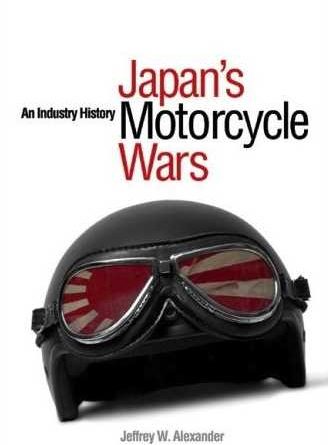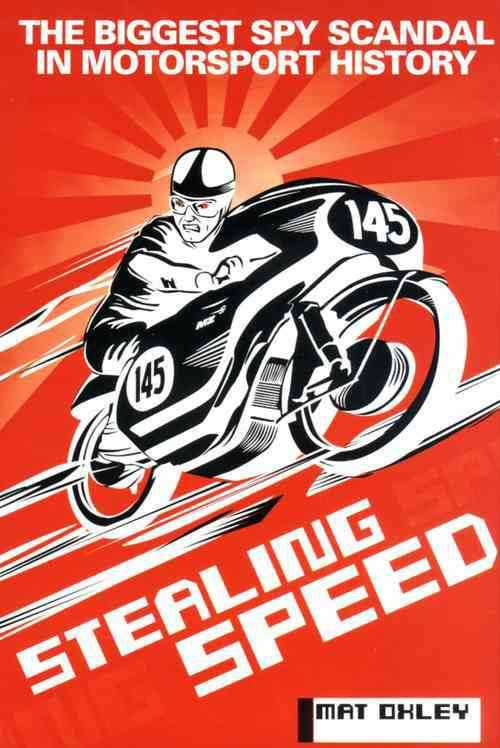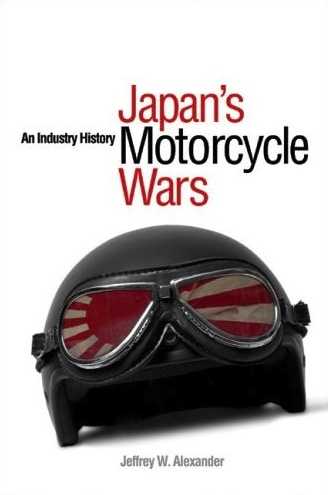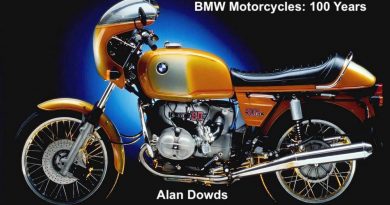Book Review ~ Spies and Samurai
Critics and reviewers get asked a lot of questions. The range goes from the absurd – do you actually read the books or see the movies you review? (Yes) – to the ridiculous – how can you pan that show or restaurant and put all those people out of work? (How can you present inferior product at inflated prices and con all that hard-earned money out of your customers?)
Somewhere near, if not at, the bottom of the list, is, how do you pick the books or movies or plays or restaurants you review? It’s the result of a series of sliding scales: new books over older books; better known writers over less famous ones; and topical interests over niche interests. It’s not just “the kindness of strangers” that leaves many a debut novel unreviewed nor the meanness of the mainstream that leaves many a motorcycle book unnoticed.
Of course there are exceptions: selections that defy logic and statistical norms. This month is one of those exceptions.
The selections grew out of a thread on Facebook among a handful of “Friends of The Rider’s Digest“. There was a documentary playing on British radio about Ernest Degner’s defection from East Germany with a suitcase full of motorcycle engineering secrets just as the Berlin Wall (and crisis) was boiling over. Though I wasn’t listening the programme – I don’t live in the UK – I could take part in the thread because I had read Stealing Speed, Mat Oxley’s very good book about the Degner affair.
After the show and thread were over, there was a brief chat with The Rider’s Digest’s overworked and overwhelmed editor, and Oxley’s book was selected for review despite its not being recent (it was published in 2009); its being a niche interest even within the motorcycling community (motorcycle history in general and racing history in particular); and Oxley himself not being exactly a household name (even if that household includes a motorcycle).
It is therefore only appropriate that riding pillion this month is a book and author even more arcane and obscure: Jeffrey W. Alexander’s Japan’s Motorcycle Wars: An Industry History. Just as well. As an Isle of Man TT winner and lap record leader, Oxley knows a thing or two about riding motorcycles, something that’s not as certain with the very scholarly Alexander.
The basic story of Degner’s defection in the summer of 1961 has been known for more than 20 years. It has been outlined in a number of motorcycle histories and encyclopedias as well as detailed in many articles in classic motorcycle magazines. Oxley credits Jan Leek’s MZ: The Racers (1991) as his source for first learning about the tale.
The summary sounds like the logline of a classic sixties spy movie: Degner, the newly anointed star racer of East Germany’s MZ factory, steals the engineering secrets that Walter Kaaden used to make a two-stroke one of the most powerful motorcycles to date. Right after Paul Petry, a friend, smuggles Degner’s wife and children past the checkpoints of the recently built Berlin Wall, Degner defects, selling Kaaden’s technology to Suzuki. Within a year, the Japanese manufacturers were dominating the racing tracks, turning Degner and Suzuki into world champions and contributing to Japan’s ultimate dominance of the global motorcycle market.
Although Stealing Speed follows the rise and fall of the more colorful Degner, Kaaden is Oxley’s real hero. Dubbing Kaaden the “father of the modern two-stroke”, Oxley details the five year period in which Kaaden revolutionized the technology. Supercharging had been prohibited in sanctioned races. Kaaden’s innovations turned the two-stroke into the little engine that could.
“He applied the German V1 and V2 rocket technology to the two-stroke.”
He applied German V1 and V2 rocket technology he worked on under Werner von Braun during World War II to the two-stroke. Kaaden developed a expansion chamber which was combined with his adaptations of earlier designs for a boost port and a rotary valve to produce a two-stroke that had twice the horsepower of a four-stroke without supercharging. He may have been the first to realize that a two-stroke is a resonant device, rather like a pipe organ. Resonance and harmonics, not valves, would produce more power.
Kaaden added rotary valve induction to the expansion chamber system. The rotary valve was a bit of pre-war technology Kaaden learned about from Daniel Zimmerman, a motorcycling friend. The boost port Kaaden found through library research. It had been used by Zundapp in the thirties. The extra transfer port fed cooler oil and gas to the overheated and under oiled pistons. “German motorcycle mechanics as well as rocket science was years ahead of everyone else,” Oxley notes dryly.
Kaaden’s two-stroke did well from its first entries in world competition in the mid-fifties. By 1959, both Kaaden and MZ had earned the respect and attention of the other racers and motorcycle companies.
But the success was colored, if not overshadowed, by two factors: the Cold War and international motorcycle racing itself. MZ reaches the pinnacle of its success at what many (including Oxley and me) consider the height of the Cold War: the two year period marked by the Bay of Pigs, the Cuban Missile Crisis, and more significant in terms of how this industrial espionage drama plays out, the Berlin Wall. Oxley is clearly of the “Commie Menace” school but he keeps things clean: what he presents here is documented, or can be. More important, it provides the context, the reasons why the stakes were so high for so many of the players.
More nuanced, detailed, and more than a bit autobiographical is Oxley’s review of the dark side of motorcycle racing at that time. Bad roads, insensitive race organizers, and primitive machines and protective gear made the sport dangerous, marked by death or career-ending injuries. Oxley cites the TT, a circuit he knows all too well, as having claimed 227 lives in its first 100 years.
“Baggy leathers, oversized Biggles steampunk goggles and pudding bowl helmets”
Circuits were not well maintained surfaces, but rather paved roads in cities or between cities. Protection was comprised of baggy leathers, oversized Biggles steampunk goggles and pudding-bowl, battle-basin helmets with padded Leia Organa ear muffs. Race organizers treated the racers as performing circus animals, though at least the Italians and Japanese treated theirs as pampered pets.
Why did the racers take risks under those conditions? Were they mercenary adrenaline junkies willing to die for glory? Oxley suggests not. It’s not a death wish. The kick comes from cheating death, going all out to edge, but coming back to tell the tale. A quote from Degner’s son, Olaf, is all the more chilling: “They risked everything…for nothing”.
Oxley doesn’t explore what was going on in Japan at the time. He leaves it that the Big Four manufacturers were upstarts who needed a technological boost such as Kaaden’s two-stroke to get noticed and thereby sell motorcycles. The hungriest was Suzuki, which at that point was last and least of the four. Its president, Suzuki Shunzo, was particularly keen to get MZ’s secret technology. The company’s fixer, Jimmy Matsumiya, was given the assignment.
Kaaden may have been approached first but turned the offer down. Degner was much more interested. He wanted the fame, fortune and freedom the West could give him, and the East could not. By 1962 Degner and Suzuki made history and won championships. Shortly after that a sad but not surprising accident (considering the conditions under which the riders raced) ended Degner’s career and he began a long decline, dying alone in 1983 at 51.
Kaaden took Degner’s defection personally but it also ended MZ’s hopes for a world championship. He went on to see other defections from his team and more of his innovations stolen, as well as the end of East Germany. He died in 1996, well after MZ: The Racers revealed to the world his contribution to motorcycle technology.
The story practically tells itself. But is the book any good? For that, let’s take a look at another German: Johann Wolfgang von Goethe. Goethe observed that there are three questions in criticism (and reviewing): What is the artist (or writer) trying to do? Did he (or she) succeed? And was it worth doing?
Oxley is attempting three things in Stealing Speed. The first is to tell the full story; the second to set up a sort of contrasting lives of Degner and Kaaden; and the third is a defense and apology for the two-stroke.
“This is motorcycle porn at its best”
He succeeds magnificently with the first. This is motorcycle porn at its best. Everything goes into the motor with a straightforward narrative drive that never loses momentum or track of the story. It’s a fast read that reads fast. Oxley gets the maximum amount of tension and suspense in the racing sequences, whether around a circuit or through military checkpoints. You won’t put it down until you finish reading it, and won’t stop talking about it (at least until your mates decide the only way to shut you up is to toss you out of a twelfth-story window).
As for the second, according to Oxley, “This book is about two men and their motorcycles: one who chose loyalty and lost, but died a happy man, the other who chose betrayal and won, but ended his life a broken man.”
Here Oxley is less successful. Part of the problem is that it would slow down the narrative drive and Oxley doesn’t let anything slow that down. Even things that initially seem extraneous turn out to be relevant by the time he finishes the book. Part of the problem is that real life isn’t ever quite that neat and symmetrical. It could just as easily be argued that the contrast is between types of loyalty: one to himself and one to his friends and co-workers. Neither man seems to have been particularly loyal to a cause or country.
More important is that what Oxley has here is a fine nest of vipers. There isn’t one person who can be described as admirable, though many do admirable things. Degner is an arrogant, self-centered thief. He didn’t need Kaaden’s secrets to defect. But he refuses to steal anything unless the deal includes freedom for his wife and children (from whom he is later estranged). Suzuki and Matsumiya aren’t much better since they commissioned the theft, though there is something funny about the Japanese stealing industrial secrets from their former allies.
The biggest stumbling block to Oxley’s conceit is his designated hero, Kaaden. Oxley claims that Kaaden was neither a Nazi nor a communist. Kaaden certainly starts out that way: he was a motorcycle nut who apprenticed at DKW while studying mechanical engineering at Chemnitz. The Nazis rise in power and Kaaden joins the Hitlerjugend, for which Oxley makes the usual disclaimers. With the war and Kaaden’s undisputed genius, he gets deployed to work with von Braun on V1 pulse jet engines.
Oxley acknowledges that he doesn’t know whether Kaaden knew about the death camps, adding that Kaaden must have heard rumors. I share Oxley’s skepticism, but more damning is that the rockets were built by slave labor under conditions that were regarded as appalling and inhumane at the time. Interestingly, and perhaps as damning, is that he destroyed much of what he had been working on to prevent any technical secrets from falling into enemy hands as Germany collapsed at the end of the war.
Kaaden hid what he had done in the war during his debrief with the Allied Forces. Declining an invitation to join von Braun in the US, Kaaden headed into the Russian sector to join his family and eventually wound up as a test engineer at MZ, declining offers to leave.
Here in the US, we have a legendary singer/songwriter named Tom Lehrer who specialized in novelty and political numbers. Back in the sixties, he wrote one of his more (in)famous ditties, Wernher von Braun, whose “allegiance is ruled by expedience” and “Don’t say he’s hypocritical, say rather he’s apolitical”.
Kaaden managed to be just as much a Vicar of Bray, but without changing his address, unlike Degner and von Braun. Kaaden was a good Nazi when the Nazis were in power; he was a good communist when the communists were in power; and he was undoubtedly a good capitalist when Germany was finally reunited.
“Well-written and well researched, it fills out an important moment in motorcycle history”
What Oxley has here is a deeply flawed figure. Like Ezra Pound, Kaaden is a man of undisputed genius, whose contributions to his field are unquestionable; unlike Pound, Kaaden never received or enjoyed the recognition for those contributions he deserved in his lifetime. As a human being Kaaden comes off as unsavory as Pound or Degner. Oxley’s assertion that Kaaden’s loyalty was somehow rewarded with happiness leaves a bad taste in the mouth.
On the other hand, without focusing on Kaaden and how he advanced two-stroke engineering, Oxley wouldn’t have set up his third point properly, which is the two-stroke itself. The epilogue not only brings the history of the two-stroke up to the date of publication (three years ago), but also speculates on a new two-stroke revival. The two-stroke turns out to be Oxley’s passion.
Simply put, he feels the two-stroke is a better engine than the four-stroke. Direct injection technology addresses the emissions issues that helped the two-stroke’s eclipse in the eighties (an eclipse supercharged by various rules changes designed to eliminate competition to the four-stroke; a direct parallel to what had happened in the fifties before Kaaden came along). Even riders not into speed can appreciate the potential advantages of the lighter, more nimble two-stroke as a street-legal vehicle. Oxley notes that KTM certainly thinks so.
Is the book worthwhile? Definitely. Well-written and well-researched, it fills out an important moment in motorcycle history. It also succeeds as a defense of the two-stroke in general. I’m sold. It wasn’t as successful in terms of the intersecting character arcs of the main players but Oxley would have to be Graham Greene or John Le Carré to pull that off, and would have produced a very, very different book.
Stealing Speed pops four out of five wheelies. If there’s not a two-stroke in your future, it’s not for want of Oxley’s efforts.
Japan’s Motorcycle Wars covers the industry before, during, and after that same critical decade that Stealing Speed does. The book explains why Suzuki took the extreme measures it did and puts the choice in the context of the period’s brutal manufacturing ecosystem of marketplace, competition, economy, rider education, and vehicle registration. By the way, Degner does get his mention – barely two paragraphs’ worth – while Kaaden gets none.
Alexander became interested in the history of motorcycle production in Japan after he stumbled across an old picture book of Japanese motorcycles built since 1945. He realized that most of the manufacturers were no longer in business. Furthermore, little information was available about how or what happened to those companies.
There had once been more than 200 manufacturers producing motorcycles and now there are four, a rate of failure greater than 98%. For an historian, the find was pure gold: it was a huge gap in the literature waiting to be filled. His research question, as a retro rocketeer might phrase it, is what ever happened to the Japanese motorcycle industry?
Alexander has a theory about the answer, as well as why the question is important: there are lessons to be learned from Japan’s experience that could be applied to Asia’s contemporary emerging economies. The academic approach requires the researcher to state clearly what he or she intends to do at the beginning, repeat it at least once a chapter, and rephrase and restate it at the end. This keeps the researcher (and any peer review) on track. It’s also a great cheat for the first of Goethe’s dicta.
According to Alexander, the surviving Big Four shared a handful of characteristics, one or more of which the dozens of other companies lacked. These are: war time precision manufacturing and management experience; the resultant understanding of the importance of mass production and die-casting techniques; the swift development of a product technologically equivalent to European models; and a strong financial position – or capacity to secure development capital for rapid investment in advanced production equipment. Suzuki, incidentally, manufactured munitions during World War II.
“In other words, if you win races, you sell motorcycles.”
The actual case studies of failure and success indicate a history of technical achievement as well as cognizance “of the design, production, and sales strategies needed to leap ahead of their competitors on the track and in the showroom.” In other words, if you win races, you sell motorcycles.
Alexander builds his case and his case studies by following changes in the economy and technology – manufacturing as well as motorcycles – along with changes in licensing and vehicle registration. He is fond of statistics about motorcycle fatalities. It’s no surprise the introduction begins with “In China, India, and Southeast Asia today an important business war is being fought among hundreds of manufacturers of one of the world’s most ubiquitous and deadly machines: the motorcycle”. His final section recommends broader driver education and tighter vehicle registration in China, India, and the “Little Dragons” of Southeast Asia.
“In 1871, it became illegal to travel by road when naked, regardless of how hot the weather was”
He writes in a good academic style. He keeps sentences short; strives for clarity, even if it means redundancy; and keeps his subordinate clauses from getting too insubordinate. His selection of anecdotes hit a nice balance between the popular and the scholarly. In 1871, it became illegal to travel by road when naked, regardless of how hot the weather was. In 1896, the first motorcycle arrived in Japan: an 1895 Hildebrand and Wolfmuller. In the early part of the 20th century the Japanese called a motorcycle tetsuba, or iron horse. The first motorcycle race was held in 1901. In 1908, Harley-Davidson began selling motorcycles in Japan, becoming over its 25 year run something of a model of sales, support, and distribution to the postwar Big Four.
In my opinion, Alexander makes his case. To ape academic phrasing, it might be worth further study to investigate whether his criteria apply to the successes and failures of motorcycle industries in other countries in general and the UK in particular during the post-war period. As such, it doesn’t just fill in a gap in the literature but expands the scope of knowledge in the field.
Given Alexander’s mania for rider and driver safety, I can’t in clear conscience rate him on the basis of one to five wheelies, a stunt he would most likely want outlawed. Instead I give him three cages, each with a full complement of air bags and seat belts.
Both books are available through Amazon. Neither man has a blog or a web site that I could find.
Jonathan Boorstein







